HRD Approaches in Zara and Marks and Spencer: A Comparative Analysis
VerifiedAdded on 2022/12/17
|12
|3482
|58
Report
AI Summary
This report provides a comprehensive analysis of human resource development (HRD) strategies employed by Zara and Marks & Spencer, two major players in the retail industry. It begins by defining HR management and the importance of continuous learning and development in the workplace. The report then delves into various learning and development need identification approaches, including setting clear expectations, creating personal development plans, conducting organizational task analysis, leveraging systems and software, and talking to employees. It also examines different levels of learning needs analysis (whole organization, specific department, and individual). The core of the report focuses on the HRD practices of Zara and Marks & Spencer, detailing their approaches to analyzing learning and development needs, specifying learning objectives, and designing learning methods. The report also highlights the strengths and weaknesses of these approaches, and the impact of learning and development on employee performance, job satisfaction, and organizational goals. The RAM model used by Zara is also discussed. The report concludes by emphasizing the positive correlation between effective HRD practices and business success.
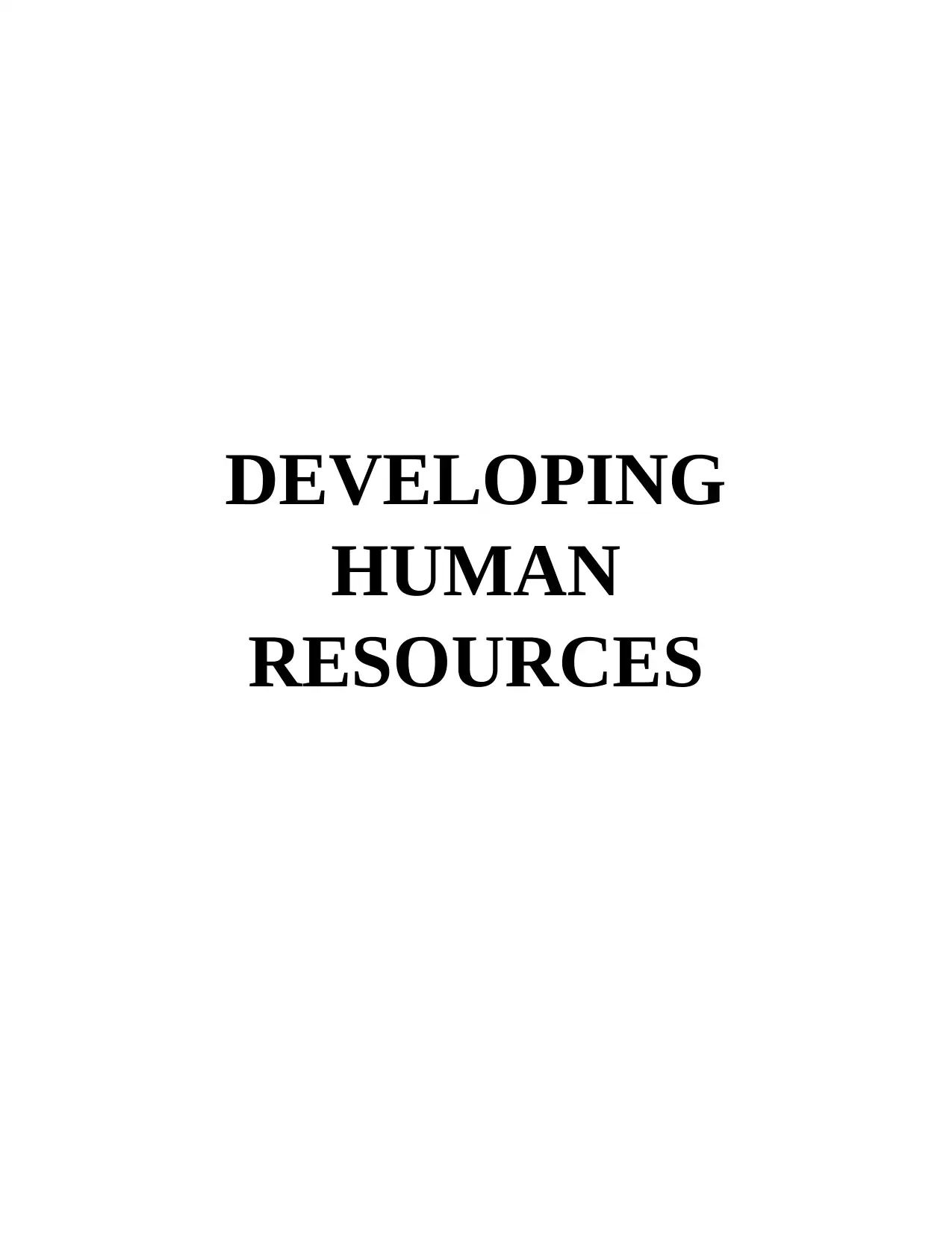
DEVELOPING
HUMAN
RESOURCES
HUMAN
RESOURCES
Paraphrase This Document
Need a fresh take? Get an instant paraphrase of this document with our AI Paraphraser
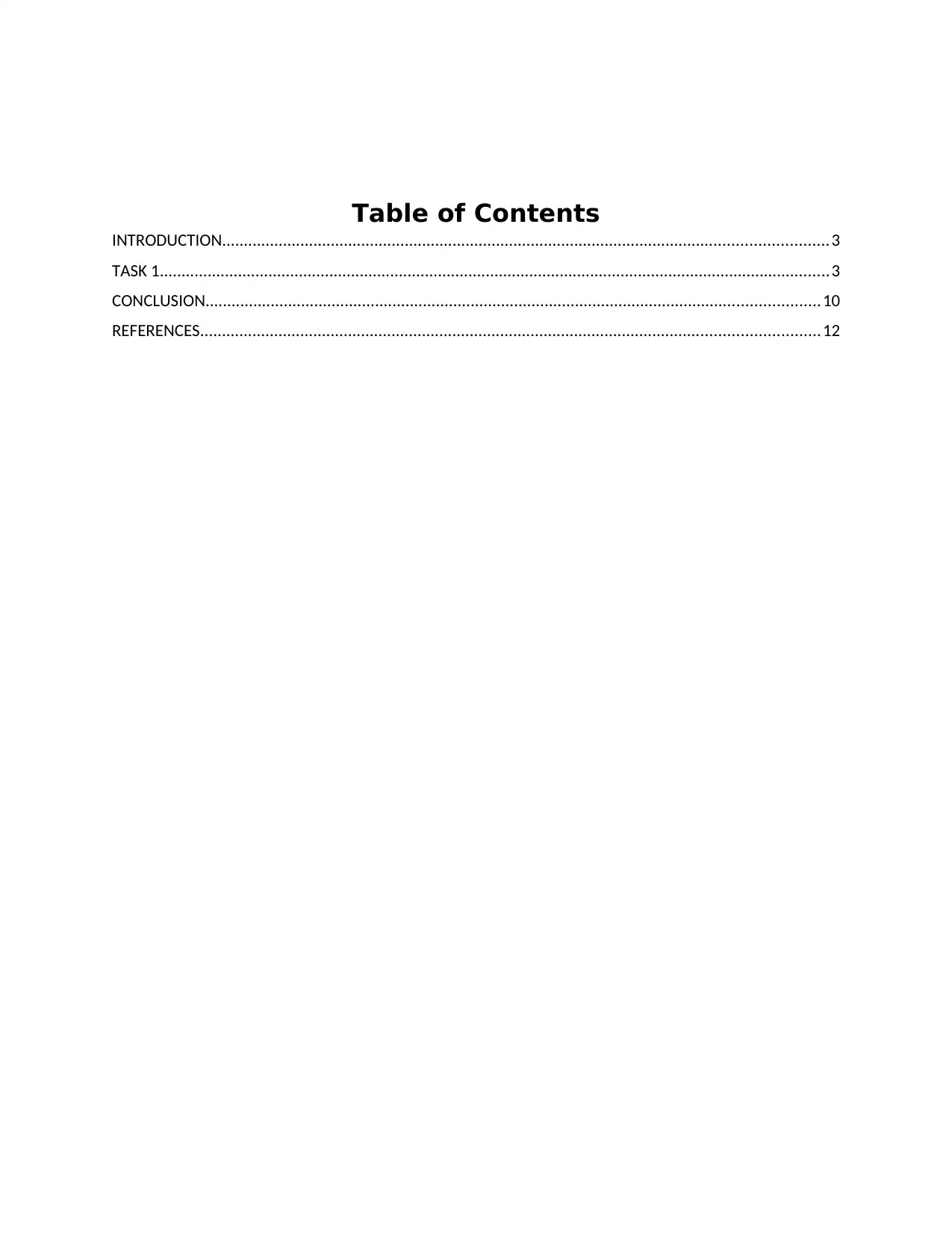
Table of Contents
INTRODUCTION...........................................................................................................................................3
TASK 1..........................................................................................................................................................3
CONCLUSION.............................................................................................................................................10
REFERENCES..............................................................................................................................................12
INTRODUCTION...........................................................................................................................................3
TASK 1..........................................................................................................................................................3
CONCLUSION.............................................................................................................................................10
REFERENCES..............................................................................................................................................12
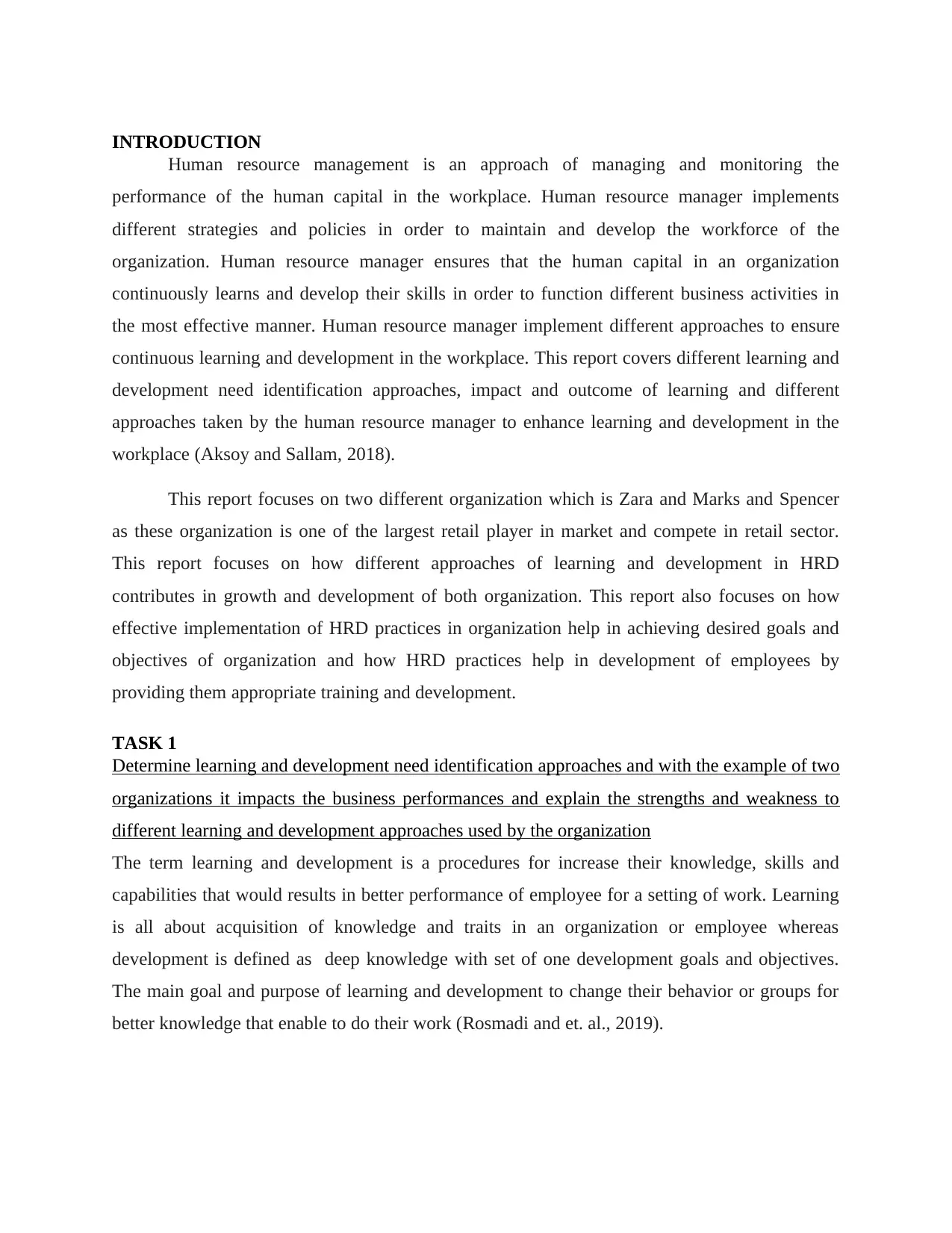
INTRODUCTION
Human resource management is an approach of managing and monitoring the
performance of the human capital in the workplace. Human resource manager implements
different strategies and policies in order to maintain and develop the workforce of the
organization. Human resource manager ensures that the human capital in an organization
continuously learns and develop their skills in order to function different business activities in
the most effective manner. Human resource manager implement different approaches to ensure
continuous learning and development in the workplace. This report covers different learning and
development need identification approaches, impact and outcome of learning and different
approaches taken by the human resource manager to enhance learning and development in the
workplace (Aksoy and Sallam, 2018).
This report focuses on two different organization which is Zara and Marks and Spencer
as these organization is one of the largest retail player in market and compete in retail sector.
This report focuses on how different approaches of learning and development in HRD
contributes in growth and development of both organization. This report also focuses on how
effective implementation of HRD practices in organization help in achieving desired goals and
objectives of organization and how HRD practices help in development of employees by
providing them appropriate training and development.
TASK 1
Determine learning and development need identification approaches and with the example of two
organizations it impacts the business performances and explain the strengths and weakness to
different learning and development approaches used by the organization
The term learning and development is a procedures for increase their knowledge, skills and
capabilities that would results in better performance of employee for a setting of work. Learning
is all about acquisition of knowledge and traits in an organization or employee whereas
development is defined as deep knowledge with set of one development goals and objectives.
The main goal and purpose of learning and development to change their behavior or groups for
better knowledge that enable to do their work (Rosmadi and et. al., 2019).
Human resource management is an approach of managing and monitoring the
performance of the human capital in the workplace. Human resource manager implements
different strategies and policies in order to maintain and develop the workforce of the
organization. Human resource manager ensures that the human capital in an organization
continuously learns and develop their skills in order to function different business activities in
the most effective manner. Human resource manager implement different approaches to ensure
continuous learning and development in the workplace. This report covers different learning and
development need identification approaches, impact and outcome of learning and different
approaches taken by the human resource manager to enhance learning and development in the
workplace (Aksoy and Sallam, 2018).
This report focuses on two different organization which is Zara and Marks and Spencer
as these organization is one of the largest retail player in market and compete in retail sector.
This report focuses on how different approaches of learning and development in HRD
contributes in growth and development of both organization. This report also focuses on how
effective implementation of HRD practices in organization help in achieving desired goals and
objectives of organization and how HRD practices help in development of employees by
providing them appropriate training and development.
TASK 1
Determine learning and development need identification approaches and with the example of two
organizations it impacts the business performances and explain the strengths and weakness to
different learning and development approaches used by the organization
The term learning and development is a procedures for increase their knowledge, skills and
capabilities that would results in better performance of employee for a setting of work. Learning
is all about acquisition of knowledge and traits in an organization or employee whereas
development is defined as deep knowledge with set of one development goals and objectives.
The main goal and purpose of learning and development to change their behavior or groups for
better knowledge that enable to do their work (Rosmadi and et. al., 2019).
⊘ This is a preview!⊘
Do you want full access?
Subscribe today to unlock all pages.

Trusted by 1+ million students worldwide
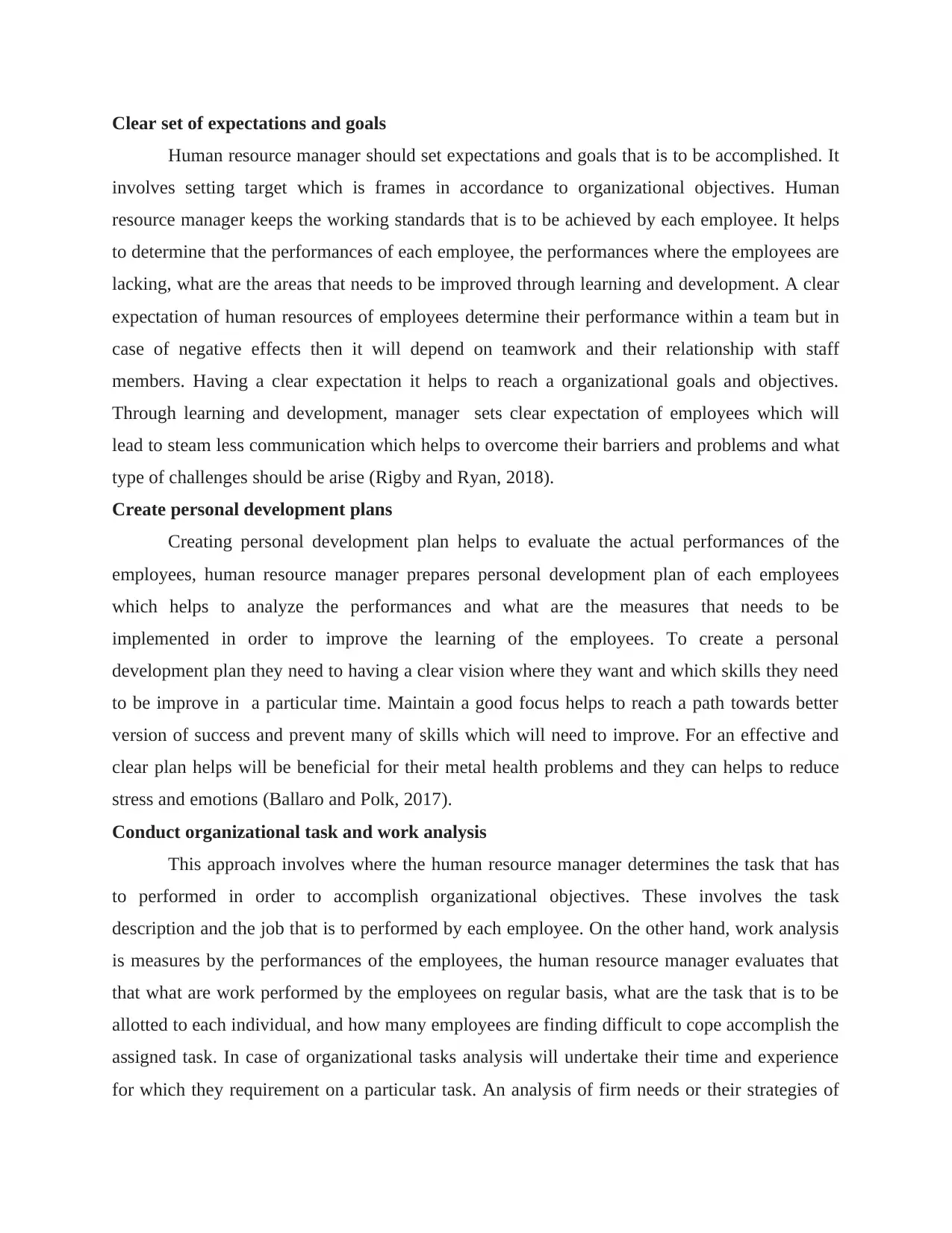
Clear set of expectations and goals
Human resource manager should set expectations and goals that is to be accomplished. It
involves setting target which is frames in accordance to organizational objectives. Human
resource manager keeps the working standards that is to be achieved by each employee. It helps
to determine that the performances of each employee, the performances where the employees are
lacking, what are the areas that needs to be improved through learning and development. A clear
expectation of human resources of employees determine their performance within a team but in
case of negative effects then it will depend on teamwork and their relationship with staff
members. Having a clear expectation it helps to reach a organizational goals and objectives.
Through learning and development, manager sets clear expectation of employees which will
lead to steam less communication which helps to overcome their barriers and problems and what
type of challenges should be arise (Rigby and Ryan, 2018).
Create personal development plans
Creating personal development plan helps to evaluate the actual performances of the
employees, human resource manager prepares personal development plan of each employees
which helps to analyze the performances and what are the measures that needs to be
implemented in order to improve the learning of the employees. To create a personal
development plan they need to having a clear vision where they want and which skills they need
to be improve in a particular time. Maintain a good focus helps to reach a path towards better
version of success and prevent many of skills which will need to improve. For an effective and
clear plan helps will be beneficial for their metal health problems and they can helps to reduce
stress and emotions (Ballaro and Polk, 2017).
Conduct organizational task and work analysis
This approach involves where the human resource manager determines the task that has
to performed in order to accomplish organizational objectives. These involves the task
description and the job that is to performed by each employee. On the other hand, work analysis
is measures by the performances of the employees, the human resource manager evaluates that
that what are work performed by the employees on regular basis, what are the task that is to be
allotted to each individual, and how many employees are finding difficult to cope accomplish the
assigned task. In case of organizational tasks analysis will undertake their time and experience
for which they requirement on a particular task. An analysis of firm needs or their strategies of
Human resource manager should set expectations and goals that is to be accomplished. It
involves setting target which is frames in accordance to organizational objectives. Human
resource manager keeps the working standards that is to be achieved by each employee. It helps
to determine that the performances of each employee, the performances where the employees are
lacking, what are the areas that needs to be improved through learning and development. A clear
expectation of human resources of employees determine their performance within a team but in
case of negative effects then it will depend on teamwork and their relationship with staff
members. Having a clear expectation it helps to reach a organizational goals and objectives.
Through learning and development, manager sets clear expectation of employees which will
lead to steam less communication which helps to overcome their barriers and problems and what
type of challenges should be arise (Rigby and Ryan, 2018).
Create personal development plans
Creating personal development plan helps to evaluate the actual performances of the
employees, human resource manager prepares personal development plan of each employees
which helps to analyze the performances and what are the measures that needs to be
implemented in order to improve the learning of the employees. To create a personal
development plan they need to having a clear vision where they want and which skills they need
to be improve in a particular time. Maintain a good focus helps to reach a path towards better
version of success and prevent many of skills which will need to improve. For an effective and
clear plan helps will be beneficial for their metal health problems and they can helps to reduce
stress and emotions (Ballaro and Polk, 2017).
Conduct organizational task and work analysis
This approach involves where the human resource manager determines the task that has
to performed in order to accomplish organizational objectives. These involves the task
description and the job that is to performed by each employee. On the other hand, work analysis
is measures by the performances of the employees, the human resource manager evaluates that
that what are work performed by the employees on regular basis, what are the task that is to be
allotted to each individual, and how many employees are finding difficult to cope accomplish the
assigned task. In case of organizational tasks analysis will undertake their time and experience
for which they requirement on a particular task. An analysis of firm needs or their strategies of
Paraphrase This Document
Need a fresh take? Get an instant paraphrase of this document with our AI Paraphraser
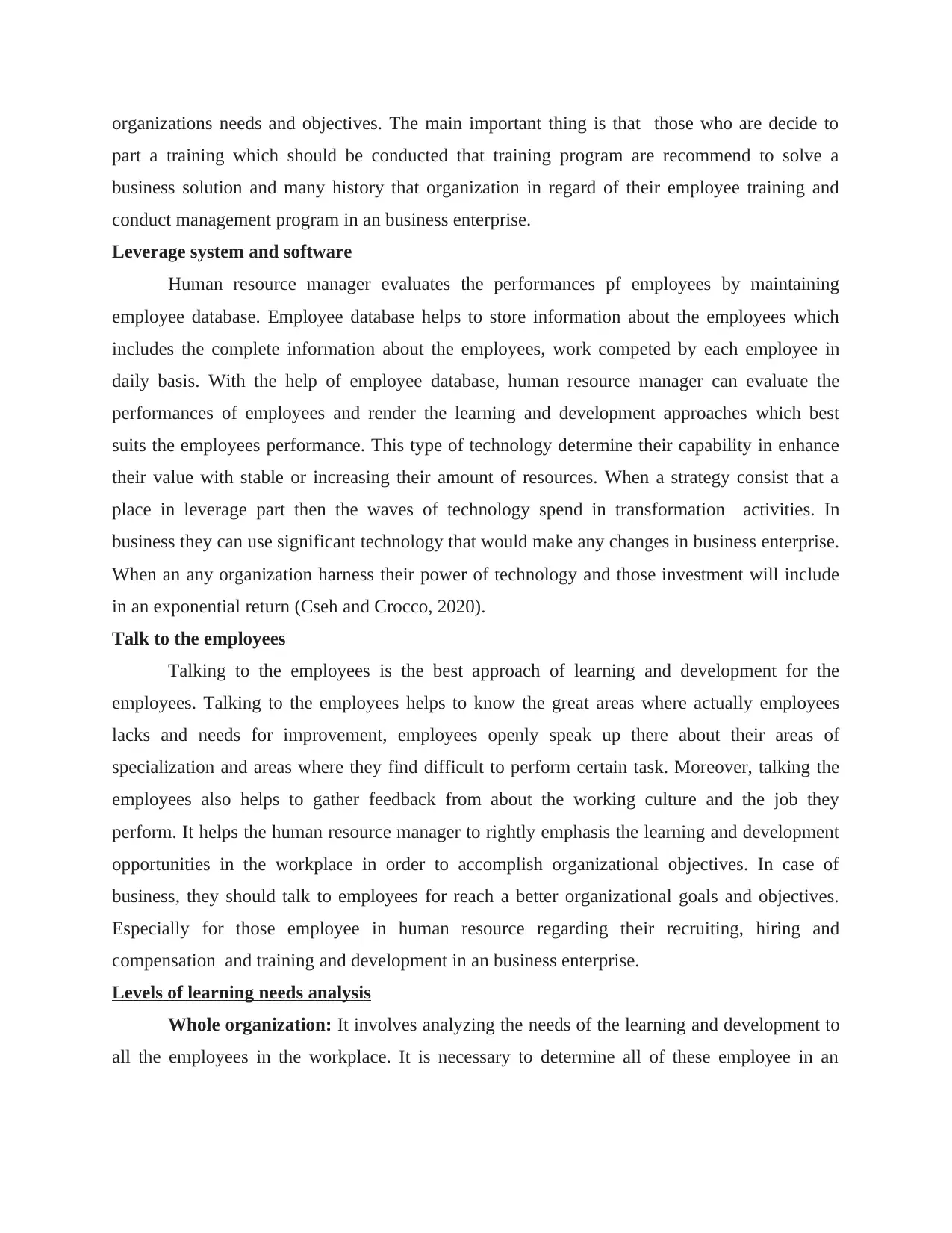
organizations needs and objectives. The main important thing is that those who are decide to
part a training which should be conducted that training program are recommend to solve a
business solution and many history that organization in regard of their employee training and
conduct management program in an business enterprise.
Leverage system and software
Human resource manager evaluates the performances pf employees by maintaining
employee database. Employee database helps to store information about the employees which
includes the complete information about the employees, work competed by each employee in
daily basis. With the help of employee database, human resource manager can evaluate the
performances of employees and render the learning and development approaches which best
suits the employees performance. This type of technology determine their capability in enhance
their value with stable or increasing their amount of resources. When a strategy consist that a
place in leverage part then the waves of technology spend in transformation activities. In
business they can use significant technology that would make any changes in business enterprise.
When an any organization harness their power of technology and those investment will include
in an exponential return (Cseh and Crocco, 2020).
Talk to the employees
Talking to the employees is the best approach of learning and development for the
employees. Talking to the employees helps to know the great areas where actually employees
lacks and needs for improvement, employees openly speak up there about their areas of
specialization and areas where they find difficult to perform certain task. Moreover, talking the
employees also helps to gather feedback from about the working culture and the job they
perform. It helps the human resource manager to rightly emphasis the learning and development
opportunities in the workplace in order to accomplish organizational objectives. In case of
business, they should talk to employees for reach a better organizational goals and objectives.
Especially for those employee in human resource regarding their recruiting, hiring and
compensation and training and development in an business enterprise.
Levels of learning needs analysis
Whole organization: It involves analyzing the needs of the learning and development to
all the employees in the workplace. It is necessary to determine all of these employee in an
part a training which should be conducted that training program are recommend to solve a
business solution and many history that organization in regard of their employee training and
conduct management program in an business enterprise.
Leverage system and software
Human resource manager evaluates the performances pf employees by maintaining
employee database. Employee database helps to store information about the employees which
includes the complete information about the employees, work competed by each employee in
daily basis. With the help of employee database, human resource manager can evaluate the
performances of employees and render the learning and development approaches which best
suits the employees performance. This type of technology determine their capability in enhance
their value with stable or increasing their amount of resources. When a strategy consist that a
place in leverage part then the waves of technology spend in transformation activities. In
business they can use significant technology that would make any changes in business enterprise.
When an any organization harness their power of technology and those investment will include
in an exponential return (Cseh and Crocco, 2020).
Talk to the employees
Talking to the employees is the best approach of learning and development for the
employees. Talking to the employees helps to know the great areas where actually employees
lacks and needs for improvement, employees openly speak up there about their areas of
specialization and areas where they find difficult to perform certain task. Moreover, talking the
employees also helps to gather feedback from about the working culture and the job they
perform. It helps the human resource manager to rightly emphasis the learning and development
opportunities in the workplace in order to accomplish organizational objectives. In case of
business, they should talk to employees for reach a better organizational goals and objectives.
Especially for those employee in human resource regarding their recruiting, hiring and
compensation and training and development in an business enterprise.
Levels of learning needs analysis
Whole organization: It involves analyzing the needs of the learning and development to
all the employees in the workplace. It is necessary to determine all of these employee in an
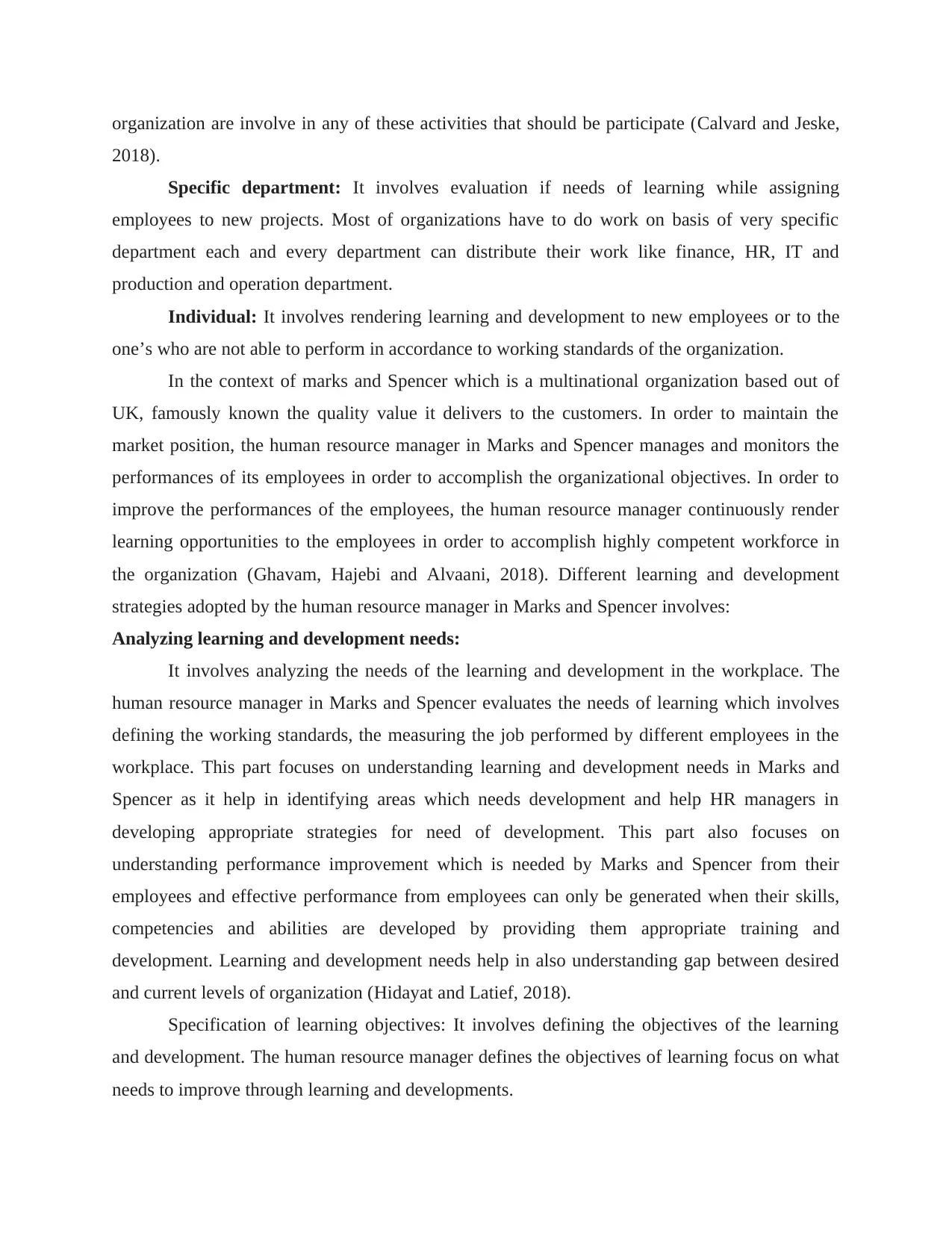
organization are involve in any of these activities that should be participate (Calvard and Jeske,
2018).
Specific department: It involves evaluation if needs of learning while assigning
employees to new projects. Most of organizations have to do work on basis of very specific
department each and every department can distribute their work like finance, HR, IT and
production and operation department.
Individual: It involves rendering learning and development to new employees or to the
one’s who are not able to perform in accordance to working standards of the organization.
In the context of marks and Spencer which is a multinational organization based out of
UK, famously known the quality value it delivers to the customers. In order to maintain the
market position, the human resource manager in Marks and Spencer manages and monitors the
performances of its employees in order to accomplish the organizational objectives. In order to
improve the performances of the employees, the human resource manager continuously render
learning opportunities to the employees in order to accomplish highly competent workforce in
the organization (Ghavam, Hajebi and Alvaani, 2018). Different learning and development
strategies adopted by the human resource manager in Marks and Spencer involves:
Analyzing learning and development needs:
It involves analyzing the needs of the learning and development in the workplace. The
human resource manager in Marks and Spencer evaluates the needs of learning which involves
defining the working standards, the measuring the job performed by different employees in the
workplace. This part focuses on understanding learning and development needs in Marks and
Spencer as it help in identifying areas which needs development and help HR managers in
developing appropriate strategies for need of development. This part also focuses on
understanding performance improvement which is needed by Marks and Spencer from their
employees and effective performance from employees can only be generated when their skills,
competencies and abilities are developed by providing them appropriate training and
development. Learning and development needs help in also understanding gap between desired
and current levels of organization (Hidayat and Latief, 2018).
Specification of learning objectives: It involves defining the objectives of the learning
and development. The human resource manager defines the objectives of learning focus on what
needs to improve through learning and developments.
2018).
Specific department: It involves evaluation if needs of learning while assigning
employees to new projects. Most of organizations have to do work on basis of very specific
department each and every department can distribute their work like finance, HR, IT and
production and operation department.
Individual: It involves rendering learning and development to new employees or to the
one’s who are not able to perform in accordance to working standards of the organization.
In the context of marks and Spencer which is a multinational organization based out of
UK, famously known the quality value it delivers to the customers. In order to maintain the
market position, the human resource manager in Marks and Spencer manages and monitors the
performances of its employees in order to accomplish the organizational objectives. In order to
improve the performances of the employees, the human resource manager continuously render
learning opportunities to the employees in order to accomplish highly competent workforce in
the organization (Ghavam, Hajebi and Alvaani, 2018). Different learning and development
strategies adopted by the human resource manager in Marks and Spencer involves:
Analyzing learning and development needs:
It involves analyzing the needs of the learning and development in the workplace. The
human resource manager in Marks and Spencer evaluates the needs of learning which involves
defining the working standards, the measuring the job performed by different employees in the
workplace. This part focuses on understanding learning and development needs in Marks and
Spencer as it help in identifying areas which needs development and help HR managers in
developing appropriate strategies for need of development. This part also focuses on
understanding performance improvement which is needed by Marks and Spencer from their
employees and effective performance from employees can only be generated when their skills,
competencies and abilities are developed by providing them appropriate training and
development. Learning and development needs help in also understanding gap between desired
and current levels of organization (Hidayat and Latief, 2018).
Specification of learning objectives: It involves defining the objectives of the learning
and development. The human resource manager defines the objectives of learning focus on what
needs to improve through learning and developments.
⊘ This is a preview!⊘
Do you want full access?
Subscribe today to unlock all pages.

Trusted by 1+ million students worldwide
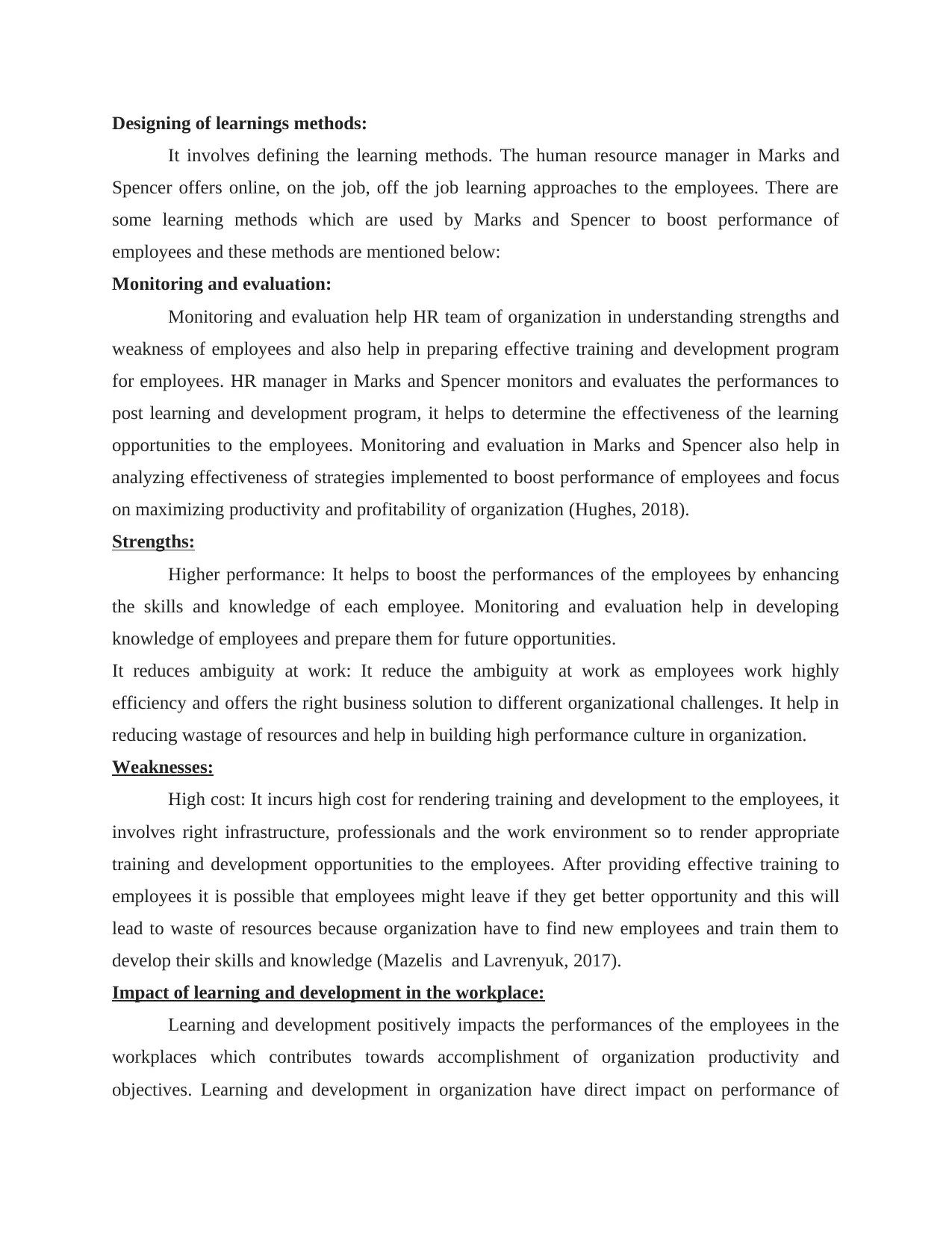
Designing of learnings methods:
It involves defining the learning methods. The human resource manager in Marks and
Spencer offers online, on the job, off the job learning approaches to the employees. There are
some learning methods which are used by Marks and Spencer to boost performance of
employees and these methods are mentioned below:
Monitoring and evaluation:
Monitoring and evaluation help HR team of organization in understanding strengths and
weakness of employees and also help in preparing effective training and development program
for employees. HR manager in Marks and Spencer monitors and evaluates the performances to
post learning and development program, it helps to determine the effectiveness of the learning
opportunities to the employees. Monitoring and evaluation in Marks and Spencer also help in
analyzing effectiveness of strategies implemented to boost performance of employees and focus
on maximizing productivity and profitability of organization (Hughes, 2018).
Strengths:
Higher performance: It helps to boost the performances of the employees by enhancing
the skills and knowledge of each employee. Monitoring and evaluation help in developing
knowledge of employees and prepare them for future opportunities.
It reduces ambiguity at work: It reduce the ambiguity at work as employees work highly
efficiency and offers the right business solution to different organizational challenges. It help in
reducing wastage of resources and help in building high performance culture in organization.
Weaknesses:
High cost: It incurs high cost for rendering training and development to the employees, it
involves right infrastructure, professionals and the work environment so to render appropriate
training and development opportunities to the employees. After providing effective training to
employees it is possible that employees might leave if they get better opportunity and this will
lead to waste of resources because organization have to find new employees and train them to
develop their skills and knowledge (Mazelis and Lavrenyuk, 2017).
Impact of learning and development in the workplace:
Learning and development positively impacts the performances of the employees in the
workplaces which contributes towards accomplishment of organization productivity and
objectives. Learning and development in organization have direct impact on performance of
It involves defining the learning methods. The human resource manager in Marks and
Spencer offers online, on the job, off the job learning approaches to the employees. There are
some learning methods which are used by Marks and Spencer to boost performance of
employees and these methods are mentioned below:
Monitoring and evaluation:
Monitoring and evaluation help HR team of organization in understanding strengths and
weakness of employees and also help in preparing effective training and development program
for employees. HR manager in Marks and Spencer monitors and evaluates the performances to
post learning and development program, it helps to determine the effectiveness of the learning
opportunities to the employees. Monitoring and evaluation in Marks and Spencer also help in
analyzing effectiveness of strategies implemented to boost performance of employees and focus
on maximizing productivity and profitability of organization (Hughes, 2018).
Strengths:
Higher performance: It helps to boost the performances of the employees by enhancing
the skills and knowledge of each employee. Monitoring and evaluation help in developing
knowledge of employees and prepare them for future opportunities.
It reduces ambiguity at work: It reduce the ambiguity at work as employees work highly
efficiency and offers the right business solution to different organizational challenges. It help in
reducing wastage of resources and help in building high performance culture in organization.
Weaknesses:
High cost: It incurs high cost for rendering training and development to the employees, it
involves right infrastructure, professionals and the work environment so to render appropriate
training and development opportunities to the employees. After providing effective training to
employees it is possible that employees might leave if they get better opportunity and this will
lead to waste of resources because organization have to find new employees and train them to
develop their skills and knowledge (Mazelis and Lavrenyuk, 2017).
Impact of learning and development in the workplace:
Learning and development positively impacts the performances of the employees in the
workplaces which contributes towards accomplishment of organization productivity and
objectives. Learning and development in organization have direct impact on performance of
Paraphrase This Document
Need a fresh take? Get an instant paraphrase of this document with our AI Paraphraser
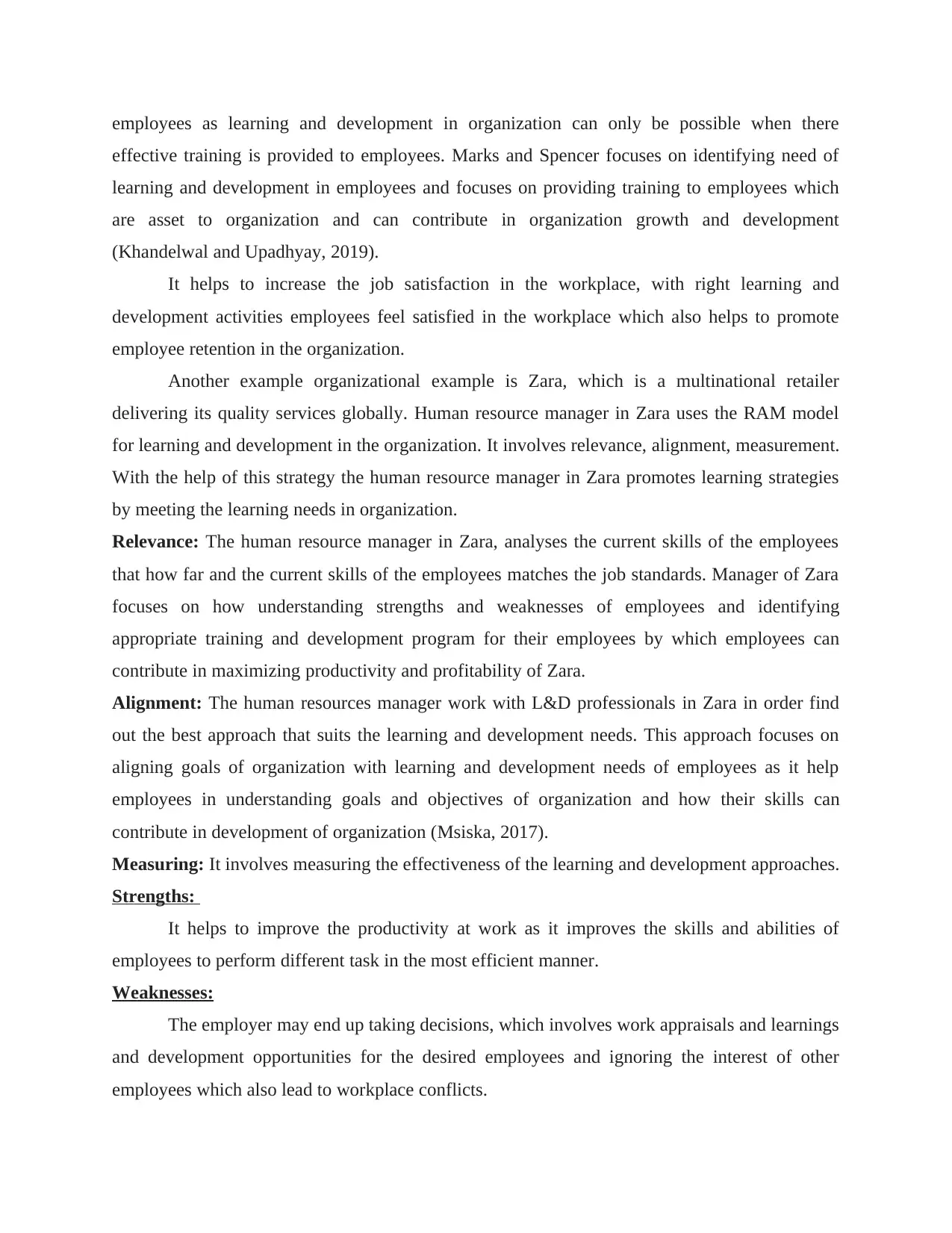
employees as learning and development in organization can only be possible when there
effective training is provided to employees. Marks and Spencer focuses on identifying need of
learning and development in employees and focuses on providing training to employees which
are asset to organization and can contribute in organization growth and development
(Khandelwal and Upadhyay, 2019).
It helps to increase the job satisfaction in the workplace, with right learning and
development activities employees feel satisfied in the workplace which also helps to promote
employee retention in the organization.
Another example organizational example is Zara, which is a multinational retailer
delivering its quality services globally. Human resource manager in Zara uses the RAM model
for learning and development in the organization. It involves relevance, alignment, measurement.
With the help of this strategy the human resource manager in Zara promotes learning strategies
by meeting the learning needs in organization.
Relevance: The human resource manager in Zara, analyses the current skills of the employees
that how far and the current skills of the employees matches the job standards. Manager of Zara
focuses on how understanding strengths and weaknesses of employees and identifying
appropriate training and development program for their employees by which employees can
contribute in maximizing productivity and profitability of Zara.
Alignment: The human resources manager work with L&D professionals in Zara in order find
out the best approach that suits the learning and development needs. This approach focuses on
aligning goals of organization with learning and development needs of employees as it help
employees in understanding goals and objectives of organization and how their skills can
contribute in development of organization (Msiska, 2017).
Measuring: It involves measuring the effectiveness of the learning and development approaches.
Strengths:
It helps to improve the productivity at work as it improves the skills and abilities of
employees to perform different task in the most efficient manner.
Weaknesses:
The employer may end up taking decisions, which involves work appraisals and learnings
and development opportunities for the desired employees and ignoring the interest of other
employees which also lead to workplace conflicts.
effective training is provided to employees. Marks and Spencer focuses on identifying need of
learning and development in employees and focuses on providing training to employees which
are asset to organization and can contribute in organization growth and development
(Khandelwal and Upadhyay, 2019).
It helps to increase the job satisfaction in the workplace, with right learning and
development activities employees feel satisfied in the workplace which also helps to promote
employee retention in the organization.
Another example organizational example is Zara, which is a multinational retailer
delivering its quality services globally. Human resource manager in Zara uses the RAM model
for learning and development in the organization. It involves relevance, alignment, measurement.
With the help of this strategy the human resource manager in Zara promotes learning strategies
by meeting the learning needs in organization.
Relevance: The human resource manager in Zara, analyses the current skills of the employees
that how far and the current skills of the employees matches the job standards. Manager of Zara
focuses on how understanding strengths and weaknesses of employees and identifying
appropriate training and development program for their employees by which employees can
contribute in maximizing productivity and profitability of Zara.
Alignment: The human resources manager work with L&D professionals in Zara in order find
out the best approach that suits the learning and development needs. This approach focuses on
aligning goals of organization with learning and development needs of employees as it help
employees in understanding goals and objectives of organization and how their skills can
contribute in development of organization (Msiska, 2017).
Measuring: It involves measuring the effectiveness of the learning and development approaches.
Strengths:
It helps to improve the productivity at work as it improves the skills and abilities of
employees to perform different task in the most efficient manner.
Weaknesses:
The employer may end up taking decisions, which involves work appraisals and learnings
and development opportunities for the desired employees and ignoring the interest of other
employees which also lead to workplace conflicts.
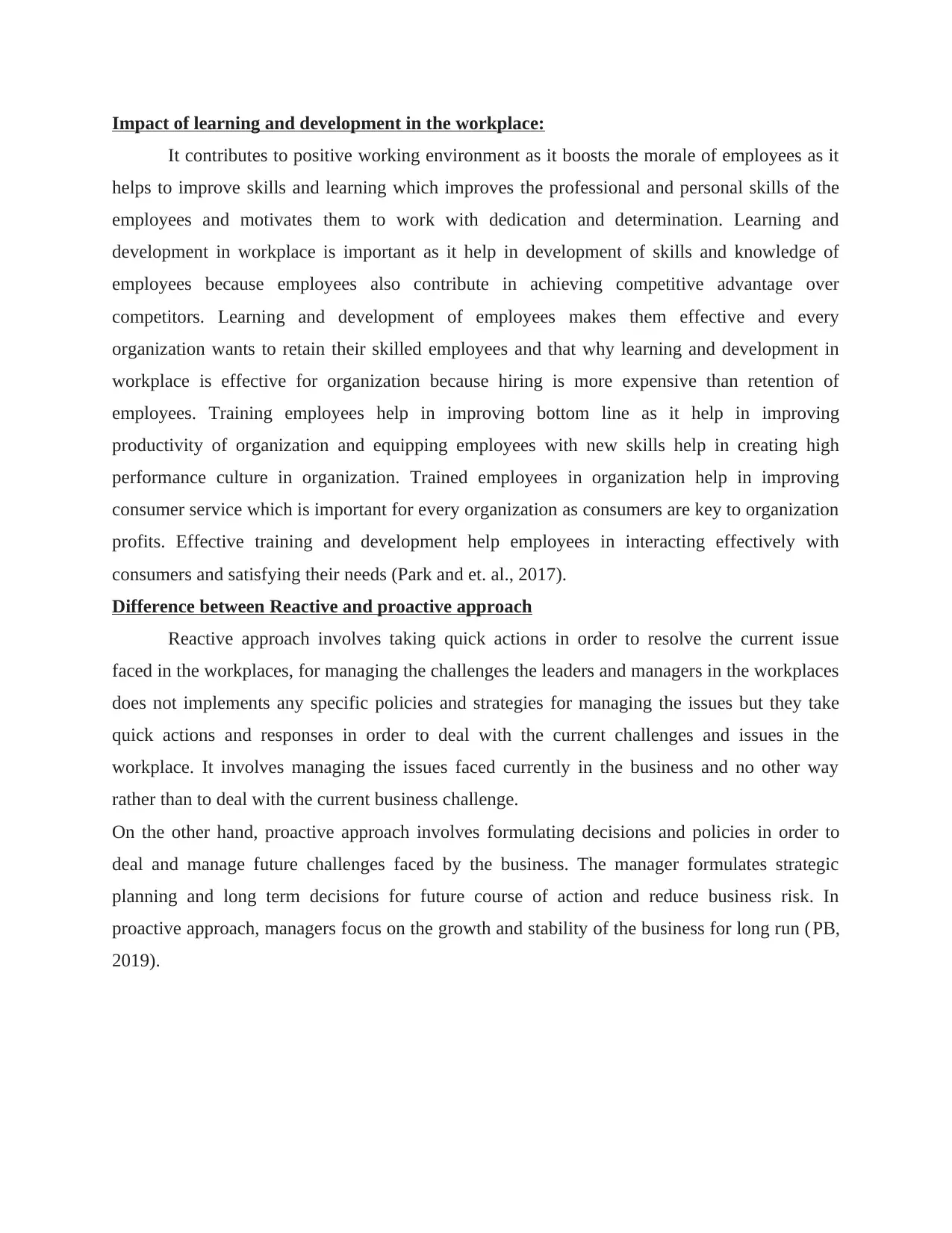
Impact of learning and development in the workplace:
It contributes to positive working environment as it boosts the morale of employees as it
helps to improve skills and learning which improves the professional and personal skills of the
employees and motivates them to work with dedication and determination. Learning and
development in workplace is important as it help in development of skills and knowledge of
employees because employees also contribute in achieving competitive advantage over
competitors. Learning and development of employees makes them effective and every
organization wants to retain their skilled employees and that why learning and development in
workplace is effective for organization because hiring is more expensive than retention of
employees. Training employees help in improving bottom line as it help in improving
productivity of organization and equipping employees with new skills help in creating high
performance culture in organization. Trained employees in organization help in improving
consumer service which is important for every organization as consumers are key to organization
profits. Effective training and development help employees in interacting effectively with
consumers and satisfying their needs (Park and et. al., 2017).
Difference between Reactive and proactive approach
Reactive approach involves taking quick actions in order to resolve the current issue
faced in the workplaces, for managing the challenges the leaders and managers in the workplaces
does not implements any specific policies and strategies for managing the issues but they take
quick actions and responses in order to deal with the current challenges and issues in the
workplace. It involves managing the issues faced currently in the business and no other way
rather than to deal with the current business challenge.
On the other hand, proactive approach involves formulating decisions and policies in order to
deal and manage future challenges faced by the business. The manager formulates strategic
planning and long term decisions for future course of action and reduce business risk. In
proactive approach, managers focus on the growth and stability of the business for long run (PB,
2019).
It contributes to positive working environment as it boosts the morale of employees as it
helps to improve skills and learning which improves the professional and personal skills of the
employees and motivates them to work with dedication and determination. Learning and
development in workplace is important as it help in development of skills and knowledge of
employees because employees also contribute in achieving competitive advantage over
competitors. Learning and development of employees makes them effective and every
organization wants to retain their skilled employees and that why learning and development in
workplace is effective for organization because hiring is more expensive than retention of
employees. Training employees help in improving bottom line as it help in improving
productivity of organization and equipping employees with new skills help in creating high
performance culture in organization. Trained employees in organization help in improving
consumer service which is important for every organization as consumers are key to organization
profits. Effective training and development help employees in interacting effectively with
consumers and satisfying their needs (Park and et. al., 2017).
Difference between Reactive and proactive approach
Reactive approach involves taking quick actions in order to resolve the current issue
faced in the workplaces, for managing the challenges the leaders and managers in the workplaces
does not implements any specific policies and strategies for managing the issues but they take
quick actions and responses in order to deal with the current challenges and issues in the
workplace. It involves managing the issues faced currently in the business and no other way
rather than to deal with the current business challenge.
On the other hand, proactive approach involves formulating decisions and policies in order to
deal and manage future challenges faced by the business. The manager formulates strategic
planning and long term decisions for future course of action and reduce business risk. In
proactive approach, managers focus on the growth and stability of the business for long run (PB,
2019).
⊘ This is a preview!⊘
Do you want full access?
Subscribe today to unlock all pages.

Trusted by 1+ million students worldwide
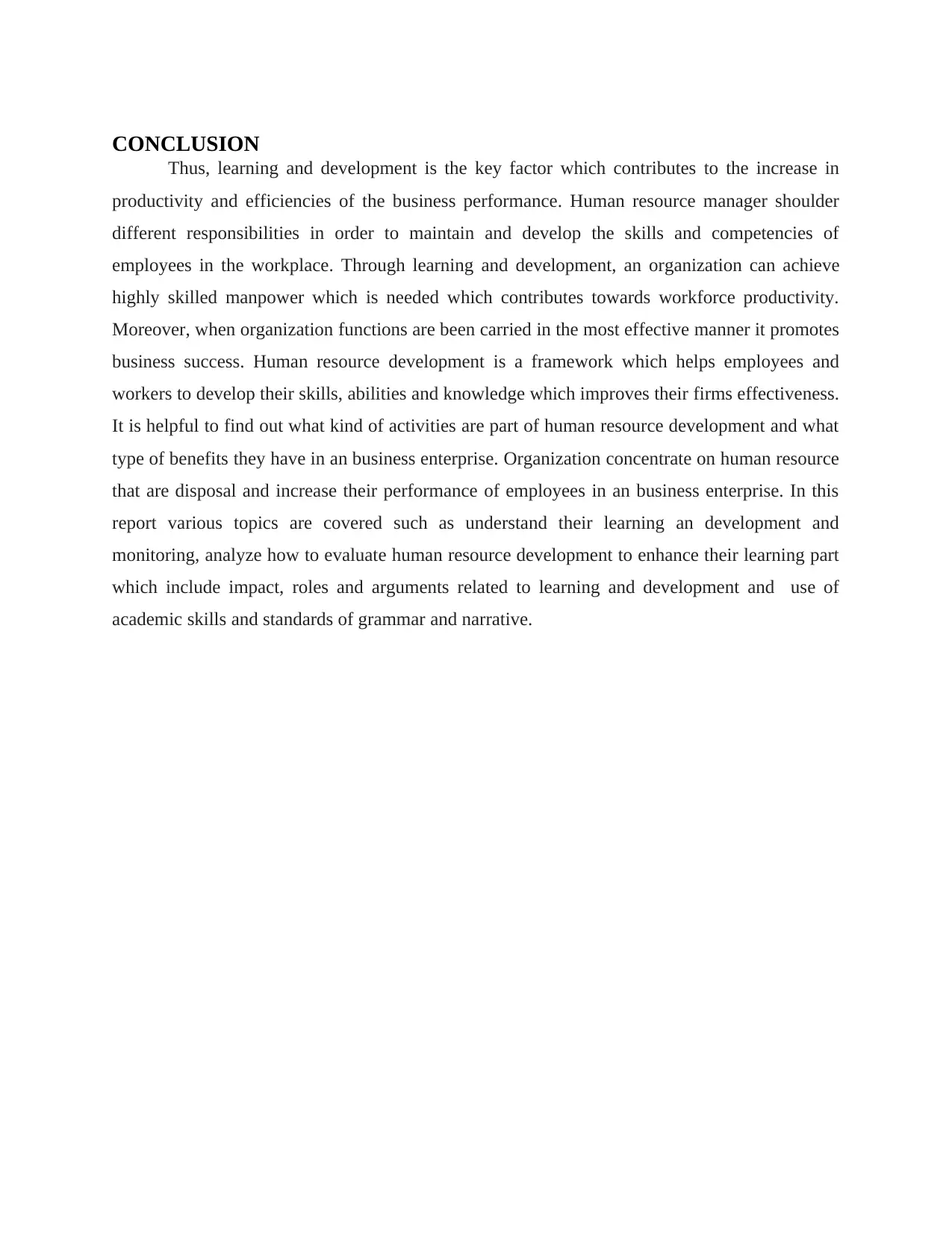
CONCLUSION
Thus, learning and development is the key factor which contributes to the increase in
productivity and efficiencies of the business performance. Human resource manager shoulder
different responsibilities in order to maintain and develop the skills and competencies of
employees in the workplace. Through learning and development, an organization can achieve
highly skilled manpower which is needed which contributes towards workforce productivity.
Moreover, when organization functions are been carried in the most effective manner it promotes
business success. Human resource development is a framework which helps employees and
workers to develop their skills, abilities and knowledge which improves their firms effectiveness.
It is helpful to find out what kind of activities are part of human resource development and what
type of benefits they have in an business enterprise. Organization concentrate on human resource
that are disposal and increase their performance of employees in an business enterprise. In this
report various topics are covered such as understand their learning an development and
monitoring, analyze how to evaluate human resource development to enhance their learning part
which include impact, roles and arguments related to learning and development and use of
academic skills and standards of grammar and narrative.
Thus, learning and development is the key factor which contributes to the increase in
productivity and efficiencies of the business performance. Human resource manager shoulder
different responsibilities in order to maintain and develop the skills and competencies of
employees in the workplace. Through learning and development, an organization can achieve
highly skilled manpower which is needed which contributes towards workforce productivity.
Moreover, when organization functions are been carried in the most effective manner it promotes
business success. Human resource development is a framework which helps employees and
workers to develop their skills, abilities and knowledge which improves their firms effectiveness.
It is helpful to find out what kind of activities are part of human resource development and what
type of benefits they have in an business enterprise. Organization concentrate on human resource
that are disposal and increase their performance of employees in an business enterprise. In this
report various topics are covered such as understand their learning an development and
monitoring, analyze how to evaluate human resource development to enhance their learning part
which include impact, roles and arguments related to learning and development and use of
academic skills and standards of grammar and narrative.
Paraphrase This Document
Need a fresh take? Get an instant paraphrase of this document with our AI Paraphraser
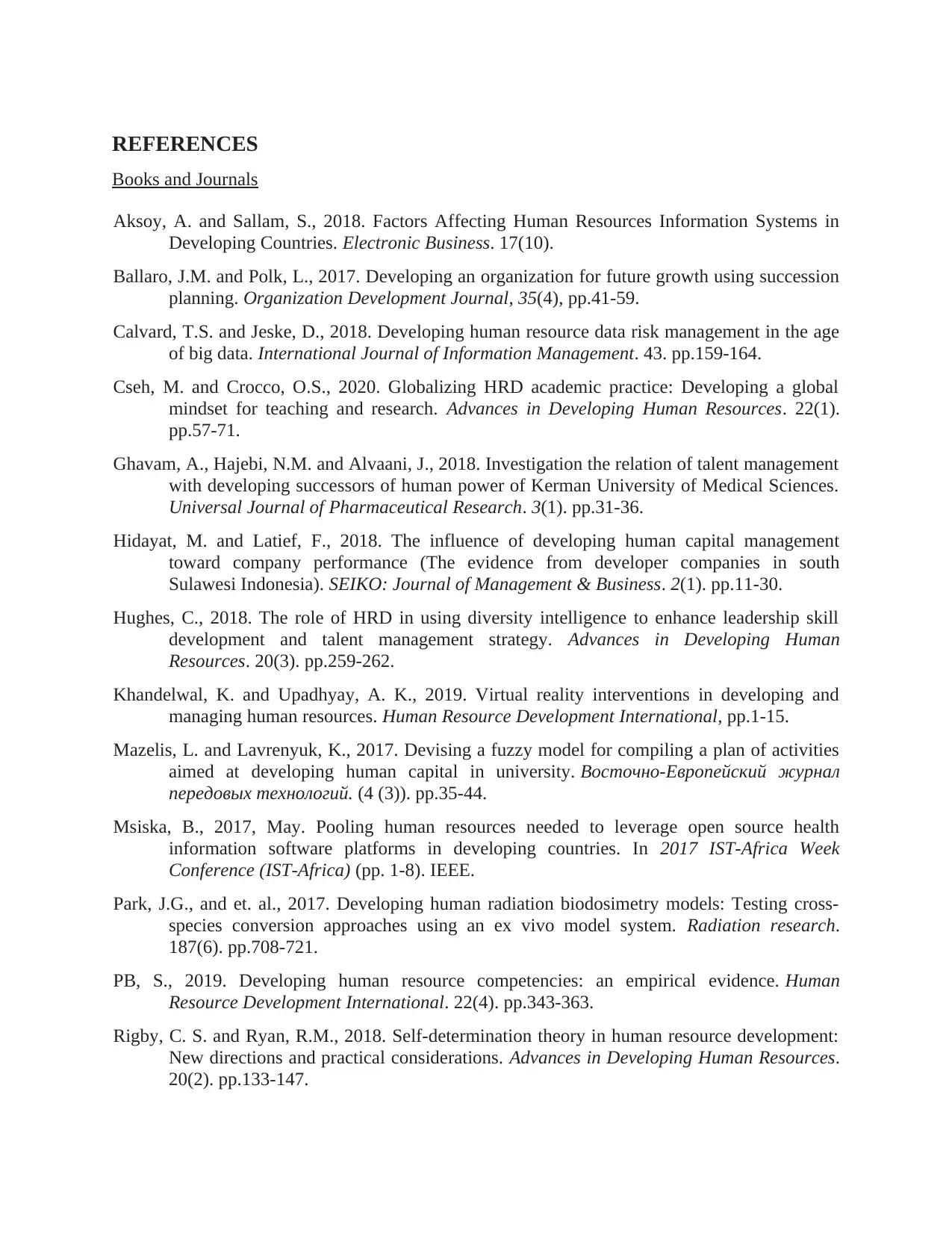
REFERENCES
Books and Journals
Aksoy, A. and Sallam, S., 2018. Factors Affecting Human Resources Information Systems in
Developing Countries. Electronic Business. 17(10).
Ballaro, J.M. and Polk, L., 2017. Developing an organization for future growth using succession
planning. Organization Development Journal, 35(4), pp.41-59.
Calvard, T.S. and Jeske, D., 2018. Developing human resource data risk management in the age
of big data. International Journal of Information Management. 43. pp.159-164.
Cseh, M. and Crocco, O.S., 2020. Globalizing HRD academic practice: Developing a global
mindset for teaching and research. Advances in Developing Human Resources. 22(1).
pp.57-71.
Ghavam, A., Hajebi, N.M. and Alvaani, J., 2018. Investigation the relation of talent management
with developing successors of human power of Kerman University of Medical Sciences.
Universal Journal of Pharmaceutical Research. 3(1). pp.31-36.
Hidayat, M. and Latief, F., 2018. The influence of developing human capital management
toward company performance (The evidence from developer companies in south
Sulawesi Indonesia). SEIKO: Journal of Management & Business. 2(1). pp.11-30.
Hughes, C., 2018. The role of HRD in using diversity intelligence to enhance leadership skill
development and talent management strategy. Advances in Developing Human
Resources. 20(3). pp.259-262.
Khandelwal, K. and Upadhyay, A. K., 2019. Virtual reality interventions in developing and
managing human resources. Human Resource Development International, pp.1-15.
Mazelis, L. and Lavrenyuk, K., 2017. Devising a fuzzy model for compiling a plan of activities
aimed at developing human capital in university. Восточно-Европейский журнал
передовых технологий. (4 (3)). pp.35-44.
Msiska, B., 2017, May. Pooling human resources needed to leverage open source health
information software platforms in developing countries. In 2017 IST-Africa Week
Conference (IST-Africa) (pp. 1-8). IEEE.
Park, J.G., and et. al., 2017. Developing human radiation biodosimetry models: Testing cross-
species conversion approaches using an ex vivo model system. Radiation research.
187(6). pp.708-721.
PB, S., 2019. Developing human resource competencies: an empirical evidence. Human
Resource Development International. 22(4). pp.343-363.
Rigby, C. S. and Ryan, R.M., 2018. Self-determination theory in human resource development:
New directions and practical considerations. Advances in Developing Human Resources.
20(2). pp.133-147.
Books and Journals
Aksoy, A. and Sallam, S., 2018. Factors Affecting Human Resources Information Systems in
Developing Countries. Electronic Business. 17(10).
Ballaro, J.M. and Polk, L., 2017. Developing an organization for future growth using succession
planning. Organization Development Journal, 35(4), pp.41-59.
Calvard, T.S. and Jeske, D., 2018. Developing human resource data risk management in the age
of big data. International Journal of Information Management. 43. pp.159-164.
Cseh, M. and Crocco, O.S., 2020. Globalizing HRD academic practice: Developing a global
mindset for teaching and research. Advances in Developing Human Resources. 22(1).
pp.57-71.
Ghavam, A., Hajebi, N.M. and Alvaani, J., 2018. Investigation the relation of talent management
with developing successors of human power of Kerman University of Medical Sciences.
Universal Journal of Pharmaceutical Research. 3(1). pp.31-36.
Hidayat, M. and Latief, F., 2018. The influence of developing human capital management
toward company performance (The evidence from developer companies in south
Sulawesi Indonesia). SEIKO: Journal of Management & Business. 2(1). pp.11-30.
Hughes, C., 2018. The role of HRD in using diversity intelligence to enhance leadership skill
development and talent management strategy. Advances in Developing Human
Resources. 20(3). pp.259-262.
Khandelwal, K. and Upadhyay, A. K., 2019. Virtual reality interventions in developing and
managing human resources. Human Resource Development International, pp.1-15.
Mazelis, L. and Lavrenyuk, K., 2017. Devising a fuzzy model for compiling a plan of activities
aimed at developing human capital in university. Восточно-Европейский журнал
передовых технологий. (4 (3)). pp.35-44.
Msiska, B., 2017, May. Pooling human resources needed to leverage open source health
information software platforms in developing countries. In 2017 IST-Africa Week
Conference (IST-Africa) (pp. 1-8). IEEE.
Park, J.G., and et. al., 2017. Developing human radiation biodosimetry models: Testing cross-
species conversion approaches using an ex vivo model system. Radiation research.
187(6). pp.708-721.
PB, S., 2019. Developing human resource competencies: an empirical evidence. Human
Resource Development International. 22(4). pp.343-363.
Rigby, C. S. and Ryan, R.M., 2018. Self-determination theory in human resource development:
New directions and practical considerations. Advances in Developing Human Resources.
20(2). pp.133-147.
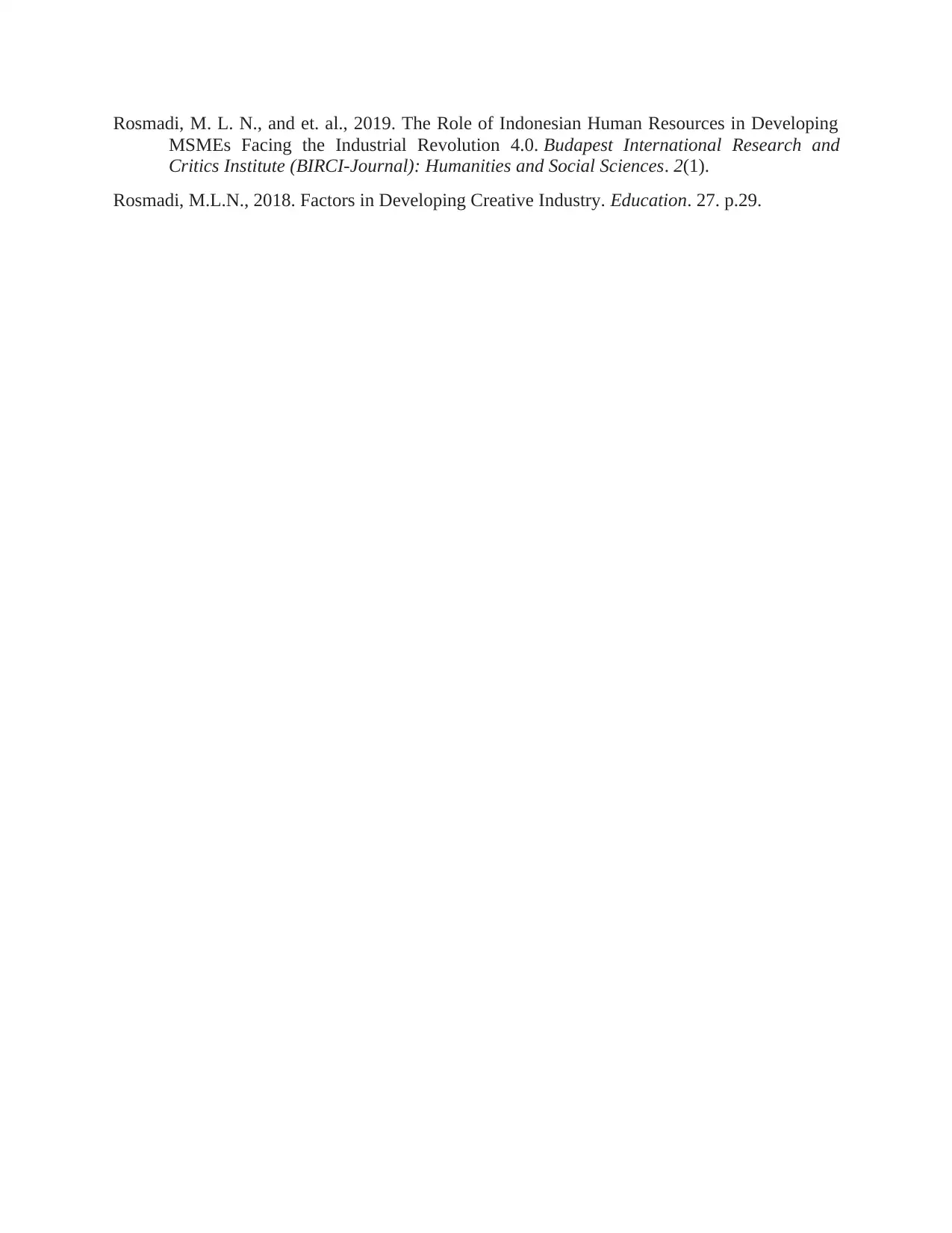
Rosmadi, M. L. N., and et. al., 2019. The Role of Indonesian Human Resources in Developing
MSMEs Facing the Industrial Revolution 4.0. Budapest International Research and
Critics Institute (BIRCI-Journal): Humanities and Social Sciences. 2(1).
Rosmadi, M.L.N., 2018. Factors in Developing Creative Industry. Education. 27. p.29.
MSMEs Facing the Industrial Revolution 4.0. Budapest International Research and
Critics Institute (BIRCI-Journal): Humanities and Social Sciences. 2(1).
Rosmadi, M.L.N., 2018. Factors in Developing Creative Industry. Education. 27. p.29.
⊘ This is a preview!⊘
Do you want full access?
Subscribe today to unlock all pages.

Trusted by 1+ million students worldwide
1 out of 12
Related Documents
Your All-in-One AI-Powered Toolkit for Academic Success.
+13062052269
info@desklib.com
Available 24*7 on WhatsApp / Email
![[object Object]](/_next/static/media/star-bottom.7253800d.svg)
Unlock your academic potential
Copyright © 2020–2025 A2Z Services. All Rights Reserved. Developed and managed by ZUCOL.





